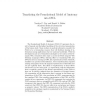Free Online Productivity Tools
i2Speak
i2Symbol
i2OCR
iTex2Img
iWeb2Print
iWeb2Shot
i2Type
iPdf2Split
iPdf2Merge
i2Bopomofo
i2Arabic
i2Style
i2Image
i2PDF
iLatex2Rtf
Sci2ools
WS
2008
ACM
2008
ACM
Translating the Foundational Model of Anatomy into OWL
The Foundational Model of Anatomy (FMA) [7] represents the result of manual and disciplined modeling of the structural organization of the human body. Many workers in medical informatics consider the FMA to be a tremendous resource that will facilitate sharing of information among applications that use anatomy knowledge. With the development and use of biomedical ontologies in the context of the Semantic Web, researchers often want to access the FMA using the Web Ontology Language (OWL). Existing efforts at translating FMA into OWL focused on creating an OWL DL representation which which DL classifiers can produce useful inference. Such transformations required making assumptions about the original representation of the FMA that are not explicitly there. Our effort is complementary to these efforts and focused on two main goals: (1) representing only the information that is explicitly present in the frames representation of the FMA or that can be directly inferred from the semantics o...
| Added | 16 Dec 2010 |
| Updated | 16 Dec 2010 |
| Type | Journal |
| Year | 2008 |
| Where | WS |
| Authors | Natalya Fridman Noy, Daniel L. Rubin |
Comments (0)

